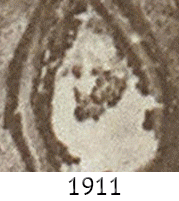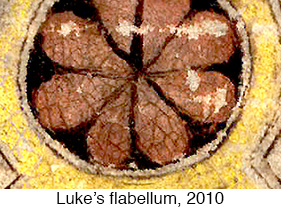Discussion of Some Results from Overlaid Historical Images
(For a full discussion, see Chapter 3: "The Otherwise Unknowable" in Digitizing Medieval Manuscripts.)
|
|
To document changes brought about by aging, exacting information is needed. Normally, inks and pigments deteriorate slowly, marked by subtle changes that are nearly impossible to detect. Without notice, small losses accumulate, and when noticed, the prior condition is impossible to recall. Further increasing the difficulty of recognizing changes is the complex decoration of an illuminated manuscript. Therefore, the exacting nature of photography is essential and digitizing past historical photographs crucial for understanding how a manuscript is holding up against time. |
|
The St Chad Gospels is fortunate to have had various photographic efforts throughout the years, even if these efforts occurred sporadically and a number of them involved only selected pages. The value of each photographic effort increases when their images are gathered and presented in a manner to provide scholars and conservators a means to compare images of the same page across time, comparisons that reveal significant information about a manuscript's aging. |
|
| I have collected images from eight such efforts for the St Chad Gospels: | |
|
1887 - photographs taken for F. H. A. Scrivener's Codex S. Ceaddea Latinus 1911 - photographs taken for Bishop Ware, Lichfield Cathedral 1929 - Photostat copy taken by the National Library of Wales, Aberystwyth 1956 - color slides likely taken by Brother Frowin Oslender, Bildarchive der Abtei Maria Laach 1962 - photographs taken by the Courtauld Institute 1982 - color transparencies taken by Sonia Halliday 2003 - color digital images taken by the British Library, in a collaboration with Lichfield Cathedral and Llandeilo Fawr 2010 - multispectral images, my efforts, in collaboration with Lichfield Cathedral |
|
|
For the St Chad Gospels, these aligned (registered) and overlaid historical images provides a view of aging over the last one hundred thirty years. Comparing them demonstrates that the manuscript has loss less pigments since Roger Powell flattened the pages in 1962. However, a few areas continue to have smaller chips of pigments break free. A telling example is the Portrait of Luke, page 218. Comparing various historical images allows a conservator or scholar to witness changes and gauge vulnerabilities. On the right-hand side, the animated GIF, a section of Luke's robe, shows chips of pigment breaking free. The largest chip was lost between 1929 and 1956, with the second largest chip lost between 1962 and 1982. The smaller of the two measures roughly .38 millimeters in width. |
 |
Two significant, full-manuscript photographic efforts occurred prior to my 2010 imaging. In 1962, the Courtauld Institute photographed the complete manuscript during Roger Powell's rebinding. These images provide a significant benchmark for conservators and scholars because they were taken with the leaves separated from the manuscript and immediately following Powell's repair and flattening of pages. Rebinding a manuscript is a rare occurrence. To have images when the binding does not hinder the photography is a rare treat indeed. Furthermore, with the photography occurring directly after Powell's repair of the pages, conservators and scholars have irreplaceable evidence for measuring and understanding the long-term effects of Powell's efforts. This understanding can provide knowledge to refine future strategies for repairing and caring for the inks, pigments, and vellum of early manuscripts. Having images from every photographic effort, even if they captured a limited number of pages, is significant. For example, in the animated gif above showing the segment of Luke's robe, without Sonia Halliday's 1982 transparencies, uncertainty would exist for Lichfield Cathedral as to whether the second largest lost chips broke free during the 2003 travel, display or imaging at and by the British Library. With the 1982 images, this can be ruled out. Similar for the 1956 slides. In comparison to the 1962 photographs, they provide visual evidence to assess how much pigment was lost during Powell's flattening of the pages. The 1956 slides rule out the largest lost chip breaking free during Powell's work. I examine these images fully in Digitizing Medieval Manuscripts, the images supplying evidence to attest to Powell's incredible care and skill. The other photographing of the complete St Chad Gospels occurred through efforts by the National Library of Wales, Aberystwyth. It produced three photostat copies, one copy presented to Lichfield Cathedral in 1929. Photostat copies are made with a Photostat machine, which uses a camera to expose an image directly onto a roll of sensitized paper. The developed sensitized paper produces a paper negative, known as a black print. To produce the desired number of copies, the black print is photographed with the Photostat machine as many times as is necessary. While a photostat copy does not provide the same sharpness as a photograph, the level of detail is ample to reveal changes in a manuscript, as seen in the above animated GIF.
A Note on Alignment I chose to align (register) all of the images to my 2010 images. I used ImageJ, free image analysis software developed by the US Institute of Health. Its plugin, BUnwarpJ, is easy to use and performs admirably. For a full discussion of my choices and method, see Chapter 3: "The Otherwise Unknowable" in Digitizing Medieval Manuscripts. Prior to 1962, the pages of the St Chad Gospels's suffered from cockling, affecting how text and imagery appear in a photograph. Also, a manuscript's binding (especially its tightness) affects the contours of a page and how it appears in an image. In viewing some of the registered images in the Historical Images Gallery, the effects of the binding and cockling can still be seen. The binding for the St Chad Gospels was remarkably different post and prior Roger Powell's work. Finally, conditions under which historical photographs are taken is impossible to know, especially those conditions' significant factors, such as relative humidity. The St Chad Gospels' pages are made from vellum (calf skin). Twelve-hundred-year-old vellum is extremely hygroscopic, absorbing moisture readily from the air. Changes in relative humidity cause pages to shrink or expand. Vellum responds far more dramatically to humidity than inks and pigments. Differences in relative humidity affect how script, decoration, and imagery align on a page when photographed, thus affecting any comparison of images taken at different times. |




